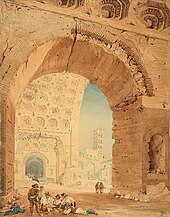Basilica of Maxentius
[1] In ancient Rome, a basilica was a rectangular building with a large central open space, and often a raised apse at the far end from the entrance.Basilicas served a variety of functions, including a combination of a court-house, council chamber and meeting hall.[1] The building consisted of a central nave covered by three groin vaults suspended 39 metres (128 ft) above the floor on four large piers, ending in an apse at the western end containing a colossal statue of Constantine (remnants of which are now in a courtyard of the Palazzo dei Conservatori of the Musei Capitolini).[citation needed] Like the great imperial baths, the basilica made use of vast interior space with its emotional effect.The only one of the eight 20-metre (66 ft) high columns that survived the earthquake was brought by Pope Paul V to Piazza Santa Maria Maggiore in 1614.On the outside wall of the basilica, facing onto the via dei Fori Imperiali, are contemporary maps showing the various stages of the rise of the Roman Empire which were added during the Fascist regime of Benito Mussolini.





BasilicaRegio IV Templum PacisMaxentiusConstantine IItalianRoman Forumancient RomenichesBattle of the Milvian BridgeVia SacraTemple of PeaceTemple of Venus and RomePaul VSanta Maria Maggioregroin vaultscolossal statue of ConstantinePalazzo dei ConservatoriMusei Capitoliniaislesarcadesgreat imperial bathsarcadeprostyletetrastyleanother earthquakePope Paul Vcoffersvia dei Fori ImperialiFascist regimeBenito Mussoliniwrestling1960 Summer Olympic GamesMarkets of TrajanBaths of DiocletianBasilica UlpiaGiovanni Battista PiranesiPenn StationColossus of ConstantineList of monuments of the Roman ForumWayback MachineTASCHEN, 2002Weitzmann, KurtMetropolitan Museum of ArtBasilica of Junius BassusBasilica of NeptuneLandmarks of RomeAurelian WallsArdeatinaAsinariaLatinaMaggioreMetroniaNomentanaPincianaPopoloPorteseSan PancrazioSan PaoloSan GiovanniSan SebastianoSettimianaTiburtinaLeonine WallCavalleggeriPertusaSanto SpiritoCastra PraetoriaJaniculum WallTerreus WallRomuli WallServian WallCaelimontanaCapenaCollinaDolabellaEsquilinaFontinalisGallienusViminaleNaeviaQuerquetulanaTrigeminaobelisksLateran ObeliskFlaminian ObeliskObelisk of MinerveoObelisk of MontecitorioAncient RomanlandmarksArch of ConstantineArch of DolabellaArch of DrususArch of GallienusArch of JanusArch of Septimius SeverusArch of TitusArcus NovusAqua AppiaAqua AlexandrinaAqua Anio VetusAqua Anio NovusAqua ClaudiaAqua JuliaAqua MarciaAqua TepulaCloaca MaximaCloaca Circi MaximiBaths of AgrippaBaths of CaracallaBaths of NeroBaths of TrajanAra PacisTemple of Antoninus and FaustinaTemple of Apollo PalatinusTemple of Apollo SosianusTemple of HadrianTemple of Hercules VictorTemple of JanusTemple of Jupiter Optimus MaximusTemple of Jupiter TonansTemple of Minerva MedicaTemple of PortunusTemple of SaturnTemple of VestaHouse of the VestalsLargo di Torre ArgentinaLupercal